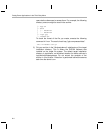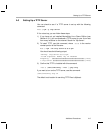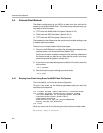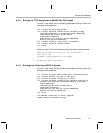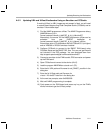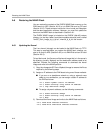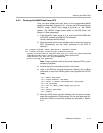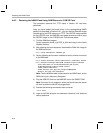
Restoring the NAND Flash
A-12
A.6 Restoring the NAND Flash
You can restore the contents of the DVSDK NAND flash memory on the
EVM board via NFS (Section A.6.2) or via RAM Disk and an SD card
(Section A.6.3). These contents include the Linux kernel and filesystem
and the demo application software. However, you must first update the
kernel on the NAND flash as described in Section A.6.1.
The DVSDK NAND image is included on the DVSDK (disk #2) restore
directory (or the http://www.ti.com/dvevmupdates extranet) and is called
"dm357_flash_image_#_#_#_#.tar", where #_#_#_# is the version.
A.6.1 Updating the Kernel
The Linux kernel (uImage) can be loaded to the NAND flash via TFTP.
This step is required before you restore the NAND flash, whether you
plan to do that via NFS (Section A.6.2) or via RAM Disk and an SD card
(Section A.6.3).
To load the kernel, the file name of the kernel image that is in the server's
tftp directory (usually /tftpboot) and the destination address need to be
specified. Execute the following commands to download the kernel
image and write to the NAND partition.
1) Copy the uImage-dm357 file to /tftpboot/uImage to rename the file as
required by the following steps.
2) Assign an IP address to the EVM board using one of these methods:
■ If you are on a standalone network or using a network cross
cable to your workstation, you can assign a static IP address to
the EVM as follows:
EVM # setenv ipaddr <static IP address>
EVM # setenv serverip <tftp server IP address>
EVM # tftp 0x80700000 uImage
■ To assign a dynamic address, use the following commands:
EVM # setenv bootfile uImage
EVM # setenv serverip <tftp server IP address>
EVM # dhcp
3) Download the kernel image and write to the NAND flash as follows:
EVM # nand erase 0x400000 0x200000
EVM # nand write 0x80700000 0x400000 0x200000



